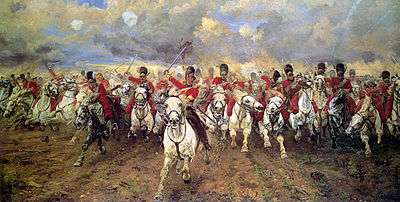Elizabeth Thompson
Elizabeth Southerden Thompson, Lady Butler (3 November 1846 – 2 October 1933) was a British painter,[1] and specialised in painting scenes from British military campaigns and battles, including the Crimean War and the Battle of Waterloo. The Roll Call (purchased by Queen Victoria), The Defence of Rorke's Drift, and Scotland Forever!, showing the Scots Greys at the Battle of Waterloo, (Leeds Art Gallery) are among her notable works. She wrote about her military paintings in an autobiography published in 1922: "I never painted for the glory of war, but to portray its pathos and heroism".[2][3][4] She married Lieutenant General Sir William Butler, becoming Lady Butler.
Elizabeth Thompson (Lady Butler) | |
|---|---|
_by_Lady_Elizabeth_Southerden_Butler_(n%C3%A9e_Thompson).jpg) Self-portrait, 1869 | |
| Born | Elizabeth Thompson 3 November 1846 |
| Died | 2 October 1933 (aged 86) Gormanston Castle, County Meath, Ireland |
| Nationality | British |
| Known for | Painting |
Notable work | Calling the Roll After An Engagement, Crimea (or The Roll Call), 1874 The 28th Regiment at Quatre Bras, 1875 |
| Movement | history painting, Military art |
Early life and education
Born at Villa Claremont in Lausanne, Switzerland, Butler was the daughter of Thomas James Thompson (1812–1881) and his second wife Christiana Weller (1825–1910). Her sister was the noted essayist and poet Alice Meynell. Elizabeth began receiving art instruction in 1862, while growing up in Italy. In 1866 she went to South Kensington, London, and entered the Royal Female School of Art. She became a Roman Catholic along with the rest of the family after they moved to Florence in 1869. While in Florence, under the tutelage of the artist Giuseppe Bellucci (1827–1882), Elizabeth attended the Accademia di Belle Arti. She signed her works as E.B.; Elizth. Thompson or Mimi Thompson (she was called "Mimi" from her childhood).[2][3][4]
Artistic career
Initially Butler concentrated on religious subjects like The Magnificat (1872), but upon going to Paris in 1870 she was exposed to battle scenes from Jean Louis Ernest Meissonier and Édouard Detaille, and switched her focus to war paintings. With the painting Missing (1873), a Franco-Prussian War battle scene depicting the common soldiers' suffering and heroism, she earned her first submission to the Royal Academy. Butler's painting The Roll Call, which depicted a line of soldiers worn out with conflict, was shown in 1874 at the Royal Academy Summer Exhibition and became so popular that a policeman had to be stationed next to the painting in order to regulate the crowds that came to see it.[5] Butler wrote that after the opening of the Summer Exhibition she awoke to find herself famous.[5]
Her fame increased as the paintings toured Europe, along with photographs of Elizabeth, she gained even more notice because people found out that she was both young and pretty, something normally not associated with painters of battle scenes. It also helped that during this time there was a huge swell of Victorian pride and romanticism for the growing British Empire.[2][3][4] While Lady Butler's topics reflected such romanticism, her paintings were generally realistic in detail with aspects such as confusion, mud and exhaustion being accurately portrayed. Her works tend to focus on British troops shown in action, or shortly after it, but avoiding scenes of hand-to-hand combat. The troops are often shown as their opponents might have seen them, but relatively few of the opponents themselves are shown.
In 1879, Butler came within two votes of becoming the first woman to be elected as an Associate Member of the Royal Academy (apart from two founder Members, Mary Moser and Angelica Kauffman; ultimately, the first female Associate Member was Annie Swynnerton, elected in 1922, and the first full Member was Laura Knight in 1936).
After her marriage in 1877 to Sir William Francis Butler (1838–1910), a distinguished officer of the British Army, from Tipperary, Ireland, Butler traveled to the far reaches of the Empire with her husband and raised their six children. During this time Lady Butler came under the influence of her Irish husband's belief that the colonial imperialism of the United Kingdom and other European powers might not be in the best interest of the natives in colonial lands. Yet she continued to paint scenes showing the valour of the ordinary British soldier. Butler also did some black and white illustration, including of poems by her sister, Alice Meynell, and of works by Thackeray. She exhibited her work at the Palace of Fine Arts and The Woman's Building at the 1893 World's Columbian Exposition in Chicago, Illinois.[6] Her daughter, Elizabeth Butler, married Lt.-Col. Randolph Albert Fitzhardinge Kingscote (b. 6 Feb 1867, d. 8 Dec 1940) on 24 July 1903.
Later life and death
On her husband's retirement from the army, she moved with him to Ireland, where they lived at Bansha Castle, County Tipperary. She showed pictures at the Royal Hibernian Academy from 1892. Among the paintings that she took with her to County Tipperary was a set of water-colours that she had painted while with her husband in Palestine. During the Irish Civil War they were transferred to her daughter in Gormanston Castle for safekeeping, but were almost all destroyed later by German bombs in London during World War II.
Lady Butler was widowed in 1910, but continued to live at Bansha until 1922, when she took up residence with the youngest of her six children, Eileen, Viscountess Gormanston, at Gormanston Castle, County Meath. She died there shortly before her 87th birthday and was interred at nearby Stamullen graveyard.[2][3][4]
Butler was included in the 2018 exhibit Women in Paris 1850-1900.[7]
Paintings
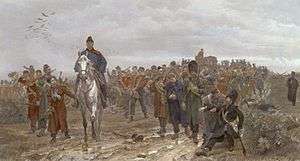
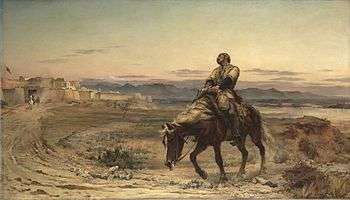
_Elizabeth_Thompson%2C_Lady_Butler.jpg)
- The Magnificat (1872)
- Missing (1873)
- Calling the Roll After An Engagement, Crimea (or The Roll Call (1874) - H.M. The Queen; Buckingham Palace)
- Missed (1874)[8]
- The 28th Regiment at Quatre Bras (1875 – National Gallery of Victoria, Melbourne)
- Balaclava (1876 – City of Manchester Art Gallery)
- The Return from Inkerman (1877 - Ferens Art Gallery, Kingston upon Hull)
- Remnants of an Army (1879 – Tate Gallery displayed at the Somerset Military Museum, Taunton)
- Listed for the Connaught Rangers (1879 – Bury Art Museum)
- The Defence of Rorke's Drift (1880 - H.M The Queen; Windsor Castle)
- Scotland Forever! (1881 – Leeds Art Gallery)
- Tel-el-Kebir (1885)
- To the Front: French Cavalry Leaving a Breton City on the Declaration of War (1888-9 - Private Collection)
- Evicted (1890 - The Irish Folklore Commission University College Dublin)
- The Camel Corps (1891)
- Halt in a Forced March (1892 - Shropshire Military Museum, Shrewsbury)
- The Rescue of the Wounded (1895)
- The Dawn of Waterloo (1895 - Falkland Palace)
- Steady the Drums and Fifes (1897 - H.M. The Queen; 57th Regiment, The Middlesex)
- Floreat Etona! (1898 - Private Collection)
- Dawn at Waterloo (1898 - Private Collection)
- The Morning of Talavera (1898)
- The Colours: Advance of the Scots Guards at the Alma (1899 - Scots Guards)
- Within Sound of Guns (1903 - painted at Bansha Castle; Staff College, Camberley)
- Stand Fast Craigellachie (1903 - National War Museum Scotland)
- Rescue of Wounded, Afghanistan (1905 - Staff College, Camberley)
- In vain! Rally for a last charge of the Cuirassiers (1912-Private Collection)
- The 16th Light Dragoons saving the remnants of the Union Brigade (1915-Private Collection)
- On the Morrow of Talavera (1923 - Private Collection)
- The Charge of The Dorset Yeomanry at Agagia, 26th February, 1916 (1917 - [The Keep Military Museum, Dorchester])
- A Lament in the Desert (1925 - Private Collection)
- In the Retreat from Mons: The Royal Horse Guards (1927 - Royal Hospital, Chelsea)
- A Detachment of Cavalry in Flanders (1929 - Private Collection)
Gallery
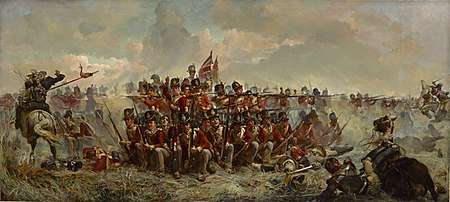
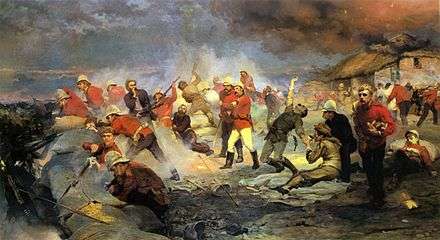
- Missed - 1874
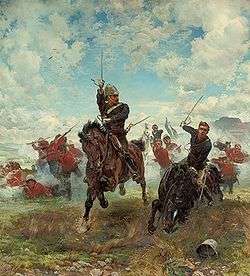
Literature
Works by
- Letters from the Holy Land (London: A & C Black, 1903).
- From Sketch-book and Diary (London: A & C Black, 1909)
- An Autobiography (London: Constable & Co., Ltd., 1923).
- Autobiography (Sevenoaks: Fisher Press, 1993). ISBN 1-874037-08-6
Works about
- Fillimore, Francis. - "Britain's Battle Painter: Lady Butler and Her Art". - New England Home Magazine. - Vol. XII, No. 13, September 1900, pp. 579–587 (also published in Windsor Magazine. - Vol. XI, December 1899-May 1900, pp. 643–652)
- Gladwell, Malcolm. (2016). "The Lady Vanishes". - Episode 1, Season 1, Revisionist History Podcast. http://revisionisthistory.com/episodes/01-the-lady-vanishes
- Gormanston, Eileen. (1953). - A Little Kept. - New York: Sheed and Ward
- Harrington, Peter. (1993). - British Artists and War: The Face of Battle in Paintings and Prints, 1700-1914. - London: Greenhill. - ISBN 1-85367-157-6
- Lalumia, Matthew Paul. - "Lady Elizabeth Thompson Butler in the 1870s". - Woman's Art Journal. - Vol. 4, No. 1, Spring-Summer 1983, pp. 9–14
- Lee, Michael. - "A Centenary of Military Painting". - Army Quarterly. - October 1967
- Meynell, Wilfrid. (1898). - The Life and Work of Lady Butler. - London: The Art Annual
- O'Byrne, M. K. - "Lady Butler". - Irish Monthly. - December 1950
- Usherwood, Paul. - "Elizabeth Thompson Butler: a case of tokenism." - Woman's Art Journal. - Vol. 11, Fall-Winter 1990-91, 14-15
- Usherwood, Paul, and Jenny Spencer-Smith, (1987). - Lady Butler, Battle Artist, 1846-1933. - Gloucester: Sutton. - ISBN 0-86299-355-5
- Walker, J. Crompton. (1927). - Irish Life & Landscape. - Dublin: Talbot Press
- Irish Arts Review. - "The Royal Scottish Academy Exhibitors 1826-1990". - Volume 4 Number 4: Winter 1987. (Calne 1991)
- Chapter 3,The Victorian Artist by Julie Codell, 2012, Cambridge UP.
- Chapter 5, Masculinities in Victorian Painting by Joseph Kestner, 1995, Scolar Press.
References
- "Butler (Elizabeth), Lady". Who's Who. Vol. 59. 1907. p. 264.
- Usherwood, Paul, and Jenny Spencer-Smith, (1987). - Lady Butler, Battle Artist, 1846-1933. - Gloucester: Sutton. - ISBN 0-86299-355-5
- Elizabeth Thompson (Lady Butler) Archived 9 December 2004 at the Wayback Machine - Spartacus Educational Schoolnet. - Retrieved: 2005-05-01
- Obituary: The Times. 3 October 1933.
- The Great Spectacle:: 250 Years of the Summer Exhibition. Royal Academy of Arts. 2018. p. 105. ISBN 978-1-910350-70-6.
- Nichols, K. L. "Women's Art at the World's Columbian Fair & Exposition, Chicago 1893". Retrieved 26 July 2018.
- Madeline, Laurence (2017). Women artists in Paris, 1850-1900. Yale University Press. ISBN 978-0300223934.
- "Lady Elizabeth Southerden Butler RI (1846-1933)".
External links
| Wikimedia Commons has media related to Elizabeth Thompson. |
- Works by Elizabeth Butler at Project Gutenberg
- Works by or about Elizabeth Thompson at Internet Archive
- Excerpt on Thompson's career from 'The Britain that Women Made', a BBC documentary by Amanda Vickery
- 18 paintings by or after Elizabeth Thompson at the Art UK site
- Portraits of Elizabeth Thompson at the National Portrait Gallery, London

